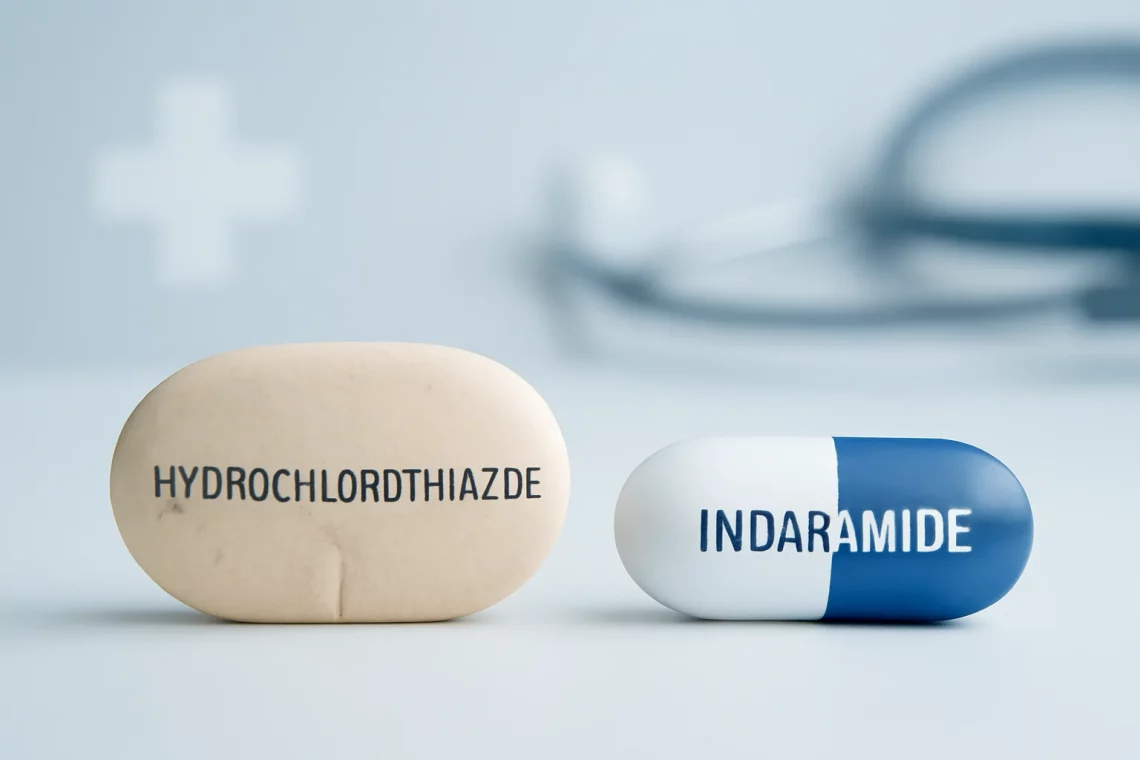
Hydrochlorothiazide vs Indapamide: Key Differences Explained
High blood pressure, also known as hypertension, is a prevalent health condition affecting millions of individuals worldwide. Often dubbed the “silent killer,” hypertension can lead to serious health complications if not managed properly. As such, effective management of blood pressure is crucial for maintaining overall health and preventing associated risks such as heart disease, stroke, and kidney problems. Among the various treatment options available, both hydrochlorothiazide and indapamide stand out as commonly prescribed diuretics. These medications play a significant role in helping patients regulate their blood pressure levels while also contributing to fluid balance in the body.
Understanding the differences and similarities between hydrochlorothiazide and indapamide can be vital for patients and healthcare providers alike. Both medications belong to the thiazide class of diuretics, yet they possess unique characteristics that may influence a physician’s choice based on individual patient needs. As patients seek to comprehend their treatment options, it is important to consider factors such as mechanism of action, potential side effects, and overall efficacy. This article delves into the nuances of hydrochlorothiazide and indapamide, exploring their roles in hypertension management and providing insights for better-informed healthcare decisions.
Mechanisms of Action
Hydrochlorothiazide and indapamide both function as diuretics, but their mechanisms of action exhibit some differences that affect their therapeutic outcomes. Hydrochlorothiazide primarily works by inhibiting sodium reabsorption in the distal convoluted tubule of the nephron, which is a part of the kidney. By blocking sodium reabsorption, hydrochlorothiazide promotes increased excretion of sodium and water, leading to a reduction in blood volume and, consequently, lower blood pressure.
Indapamide, while also acting on the distal convoluted tubule, is classified as a thiazide-like diuretic. Its mechanism is somewhat similar, yet it has an additional action on the vascular smooth muscle, which helps in vasodilation. This dual action may make indapamide particularly effective in lowering blood pressure, as it not only reduces fluid volume but also relaxes blood vessels, allowing for easier blood flow.
The differences in their mechanisms can influence the choice of medication for certain patients. For example, patients who may experience significant fluid retention might benefit more from hydrochlorothiazide, while those who require additional blood vessel relaxation might find indapamide to be a more suitable option. Additionally, the onset of action and duration of effects vary, with hydrochlorothiazide typically having a more rapid onset but shorter duration compared to indapamide. Understanding these differences can help healthcare providers tailor treatment plans to meet individual patient needs effectively.
Potential Side Effects
As with any medication, both hydrochlorothiazide and indapamide come with potential side effects that patients should be aware of. Hydrochlorothiazide is known to cause electrolyte imbalances, particularly hypokalemia, which is a condition characterized by low potassium levels in the blood. Other common side effects include increased urination, dizziness, and in some cases, allergic reactions such as rash or hives. Long-term use of hydrochlorothiazide may also contribute to elevated blood sugar levels, which could be a concern for diabetic patients.
Indapamide, while sharing some side effects with hydrochlorothiazide, tends to have a more favorable side effect profile. One of the key advantages of indapamide is its lower incidence of hypokalemia compared to hydrochlorothiazide. This can be particularly beneficial for patients who are at risk for low potassium levels or who are already managing other conditions such as heart disease.
Patients should also consider the potential for interactions with other medications when choosing between these two options. Hydrochlorothiazide has well-documented interactions with certain non-steroidal anti-inflammatory drugs (NSAIDs) and medications used to treat diabetes, while indapamide may have fewer interactions due to its different metabolic pathways.
In light of these side effects and interactions, patients are encouraged to discuss their health history and current medications with their healthcare provider to determine which option may be the safest and most effective for them.
Clinical Efficacy
The clinical efficacy of hydrochlorothiazide and indapamide has been demonstrated in numerous studies focusing on the management of hypertension. Both medications have shown the ability to lower blood pressure effectively, but they may differ in terms of long-term outcomes and patient adherence.
Hydrochlorothiazide has been a staple in hypertension treatment for decades, and its effectiveness in reducing systolic and diastolic blood pressure is well-documented. It has also been shown to reduce the risk of cardiovascular events, making it a reliable choice for many patients. However, the need for frequent dosing and the potential for side effects may lead some patients to struggle with adherence to their treatment regimen.
Indapamide, on the other hand, has gained traction in recent years due to its unique properties. Studies have indicated that indapamide may offer superior blood pressure control with a once-daily dosing schedule, which can improve patient compliance. Furthermore, the additional vasodilatory effect may provide added benefits in terms of cardiovascular protection, making it an attractive alternative for some patients.
Ultimately, the choice between hydrochlorothiazide and indapamide may depend on a variety of factors, including patient-specific needs, potential side effects, and individual responses to treatment. Continuous monitoring and regular follow-ups with healthcare providers can ensure that patients receive the most effective therapy for their unique circumstances.
Conclusion
In summary, both hydrochlorothiazide and indapamide play significant roles in the management of hypertension, each with its own set of advantages and considerations. Understanding the differences in their mechanisms of action, potential side effects, and clinical efficacy can empower patients to engage in informed discussions with their healthcare providers. While both medications are effective in lowering blood pressure, the choice of which to use may ultimately depend on individual patient factors and preferences.
As always, patients are advised to consult with their healthcare professionals before making any changes to their medication regimen. This article is intended for informational purposes only and should not be construed as medical advice. Always seek the guidance of a qualified healthcare provider for any health-related concerns or questions.




